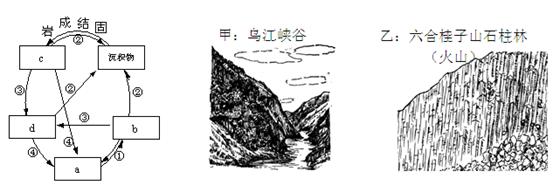问题
选择题
图为岩石圈物质循环示意图及两幅地貌景观图。读图完成题。

小题1:“岩石圈物质循环示意图”中属于沉积岩的是
A.a
B.b
C.c
D.d小题2:形成甲图所示地貌的主要外力作用是
A.流水的侵蚀作用
B.流水的堆积作用
C.风力的侵蚀作用
D.波浪的侵蚀作用小题3:在岩石圈物质循环示意图中,能反映乙图中岩石形成过程的是
A.①
B.②
C.③
D.④
答案
小题1:C
小题2:A
小题2:A
题目分析:
小题1:“岩石圈物质循环示意图”中属于沉积岩的是c。因为指向c的箭头表示固结成岩作用,为外力作用,在外力作用下,只能转化为沉积岩。
小题2:甲图为乌江峡谷,形成甲图所示地貌的主要外力作用是流水的侵蚀作用。流水侵蚀形成“V”型谷。
小题3:乙图为六合桂子山石柱林,为火山喷出形成的岩浆岩,在岩石圈物质循环示意图中,能反映乙图中岩石形成过程的是①。因为图中a为岩浆,b为岩浆岩。①代表的作用为上升冷却凝固。
点评:本题难度较小,主要考查了学生对所学知识的灵活运用能力,学生结合所学知识不难作答。对于地质作用与地表形态的命题规律简单分析如下:从考查内容看,“地质作用与形成地貌”是近年来高考的一个热点;从考查形式上看,多数以选择题为主,非选择题多是描述地貌特征和分析地形地貌对人类活动的影响;从考查能力上看,直接考查名词、概念的试题不多,对理论和联系实际的能力要求高。
